In the realm where dragons soar and kingdoms clash, the epic saga of ”Game of Thrones” unfolds with breathtaking battles that have captivated millions. Behind the screen, a dedicated army of creators, choreographers, and special effects wizards bring these monumental conflicts to life, transforming George R.R. Martin’s vivid imagination into a visual feast. This article delves into the intricate process behind the series’ most iconic battles, exploring the artistry, technology, and relentless passion that forge the chaos and beauty of war in Westeros. Journey with us as we uncover the secrets and stories behind the epic clashes that have left an indelible mark on television history.
Crafting the Chaos: Behind the Scenes of Battle Choreography
The intricate dance of swords and shields in Game of Thrones is a testament to meticulous planning and creative vision. Behind every epic clash lies a team of skilled choreographers, dedicated to transforming scripts into visceral spectacles. Each battle sequence begins with storyboarding, where the action is plotted out frame by frame. This is followed by intense rehearsals where actors and stunt doubles learn complex moves, ensuring safety while maintaining authenticity.
- Collaboration: Directors, choreographers, and actors work closely to ensure the narrative drives the combat.
- Authenticity: Historical combat techniques are studied to enhance realism.
- Innovation: Unique camera angles and CGI are used to amplify the chaos.
Special attention is given to each character’s fighting style, reflecting their personality and background. Whether it’s Arya’s agile movements or The Mountain’s brute force, every detail is crafted to perfection, immersing viewers in the heart of Westeros’ most legendary battles.
The Art of War: Special Effects and Cinematic Magic
The legendary battles of Game of Thrones owe much of their visceral impact to the seamless blend of special effects and cinematic techniques. Behind every sword clash and dragon roar lies a meticulous process that transforms script to screen magic. Visual effects artists painstakingly crafted each frame, using a combination of CGI and practical effects to create realistic landscapes and terrifying creatures. For instance, the dragons, with their fiery breath and majestic wings, were brought to life through a blend of motion capture and digital animation, resulting in creatures that felt as real as the actors sharing the screen with them.
- Practical Effects: Real fire, smoke, and debris enhanced the authenticity of battle scenes.
- Advanced CGI: Layered with live-action to create seamless, immersive environments.
- Miniatures and Models: Used for large-scale set pieces, providing depth and realism.
Moreover, the cinematography played a pivotal role, employing techniques like handheld camera work to convey the chaos of battle, and sweeping aerial shots to capture the epic scale. This intricate choreography of elements ensured that every clash felt both intimate and grand, a testament to the show’s dedication to crafting unforgettable war sequences.

Forging Realism: The Role of Historical Consultants
In the intricate tapestry of Westeros, the battles that unfold are not just products of vivid imagination but also the meticulous work of historical consultants. These experts play a pivotal role in crafting the authenticity that fans of ”Game of Thrones” have come to expect. By delving deep into the annals of medieval warfare, consultants provide insights that shape everything from strategic maneuvers to the design of weaponry.
Key contributions of historical consultants include:
- Battle Tactics: Advising on formations and strategies that mirror real-world historical conflicts.
- Armor and Weaponry: Ensuring that the swords, shields, and armor reflect the era’s craftsmanship.
- Cultural Nuances: Bringing to life the customs and hierarchies that influence the dynamics of war.
Their expertise ensures that the battles are not only visually stunning but also grounded in a semblance of reality, bridging the gap between fantasy and history.

Lessons from the Battlefield: Tips for Aspiring Filmmakers
- Plan Meticulously: Every battle scene in Game of Thrones was a result of intricate planning. Aspiring filmmakers should prioritize storyboarding and pre-visualization to ensure that each shot is purposeful and aligns with the narrative.
- Embrace Collaboration: The scale of the series’ battles required seamless teamwork across departments. Foster open communication and trust among your crew to harness diverse talents and perspectives.
- Innovate with Technology: Cutting-edge techniques like CGI and motion capture were pivotal. Stay updated on the latest tech advancements and consider how they can enhance your storytelling.
- Commit to Authenticity: Despite the fantasy setting, the show’s creators focused on realistic choreography and practical effects. Strive for authenticity to ground your audience in the world you’re building.
- Adaptability is Key: Weather, location constraints, and unexpected challenges are inevitable. Cultivate flexibility and problem-solving skills to navigate these hurdles creatively.

